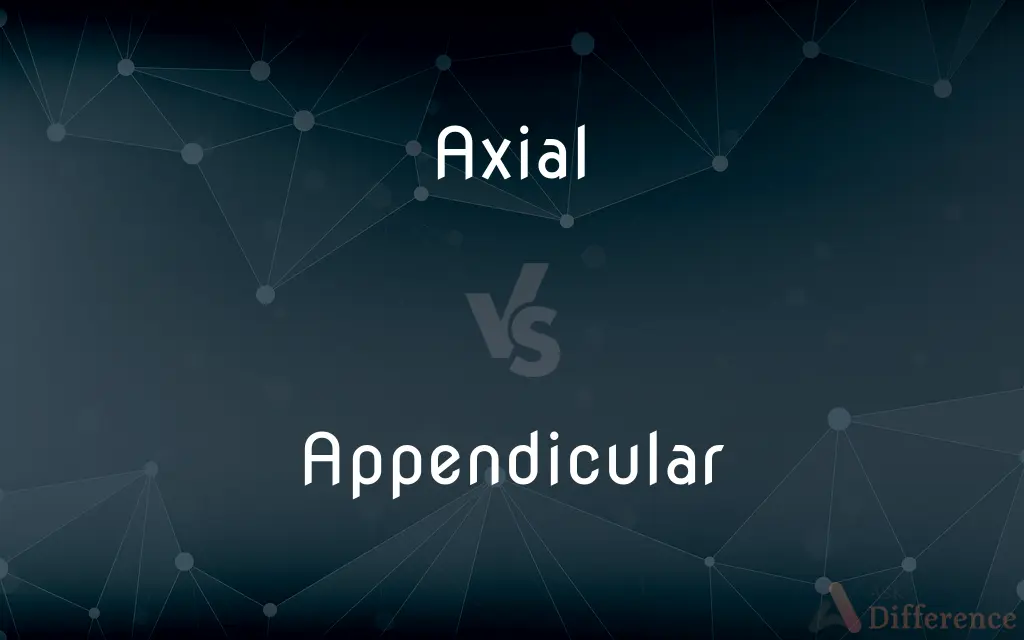Axial vs. Appendicular — What's the Difference?
Edited by Tayyaba Rehman — By Urooj Arif — Updated on March 20, 2024
The axial skeleton forms the central core of the body, including the skull, spine, and rib cage, whereas the appendicular skeleton consists of the limbs and girdles, facilitating movement and interaction with the environment.

Difference Between Axial and Appendicular
Table of Contents
ADVERTISEMENT
Key Differences
The axial skeleton serves as the body's main framework, providing support and protection for the brain, spinal cord, and vital organs within the thorax. It comprises 80 bones, including the vertebral column, rib cage, and skull, and plays a crucial role in posture and support. The appendicular skeleton, on the other hand, includes 126 bones in the limbs, shoulder girdle, and pelvic girdle, enabling a wide range of movements and interactions with the environment. This division allows the body to perform complex tasks such as walking, running, and manipulating objects.
While the axial skeleton's primary function is to support and protect, the appendicular skeleton's design focuses on mobility and manipulation. The shoulder girdle and pelvic girdle serve as attachment points for the limbs, facilitating movements like lifting, grabbing, and locomotion. The distinction between these two skeletal systems underscores the body's ability to balance stability with flexibility and movement.
Developmentally, the axial and appendicular skeletons have distinct origins, with the axial skeleton typically developing from the notochord and associated structures, and the appendicular skeleton forming from the limb buds during embryonic development. This differentiation in development reflects their differing roles in the body's structure and function.
Despite their differences, both skeletal systems work in concert to enable the body's complex movements and functions. The axial skeleton provides a stable foundation for the appendicular skeleton, which, in turn, enables interaction with the external environment through movement. The integration of these systems is essential for physical activities ranging from basic daily tasks to athletic performance.
In pathological conditions, diseases and disorders may affect the axial and appendicular skeletons differently, reflecting their distinct anatomical structures and functions. Conditions such as osteoporosis, arthritis, and traumatic injuries may present differently within these two parts of the skeleton, influencing treatment and management approaches.
ADVERTISEMENT
Comparison Chart
Components
Skull, vertebral column, rib cage, hyoid bone, auditory ossicles
Limbs (arms and legs), shoulder girdle, pelvic girdle
Function
Supports and protects the brain, spinal cord, and thoracic organs
Facilitates movement and interaction with the environment
Number of Bones
80
126
Primary Role
Provides central support and protects vital organs
Enables mobility and manipulation of objects
Development Origin
Notochord and associated structures
Limb buds during embryonic development
Associated Actions
Breathing, posture, support
Locomotion, manipulation of objects, physical interaction
Key Structures
Vertebral column, skull, ribs
Humerus, femur, clavicle, pelvis
Disorders
Spinal disorders, rib fractures, skull abnormalities
Fractures in limbs, joint dislocations, arthritis in shoulders or hips
Compare with Definitions
Axial
Central supporting structure of the body.
The vertebral column of the axial skeleton protects the spinal cord.
Appendicular
Includes bones of the limbs for movement.
The femur in the appendicular skeleton is critical for walking and running.
Axial
Comprises the skull, protecting the brain.
The axial skeleton's skull includes the cranium and facial bones.
Appendicular
Encompasses the pelvic girdle, supporting the lower limbs.
The pelvis of the appendicular skeleton provides a sturdy base for the legs.
Axial
Includes the rib cage for organ protection.
The rib cage of the axial skeleton encases and safeguards the heart and lungs.
Appendicular
Contains the shoulder girdle for arm attachment.
The clavicle and scapula form the appendicular skeleton's shoulder girdle.
Axial
Involves the hyoid bone, supporting the tongue.
The hyoid bone in the axial skeleton aids in swallowing and speech.
Appendicular
Enables manipulation of objects.
The appendicular skeleton's phalanges allow for precise hand movements.
Axial
Contains the auditory ossicles, essential for hearing.
The tiny bones in the axial skeleton's middle ear transmit sound vibrations.
Appendicular
Facilitates physical interaction with the environment.
The appendicular skeleton's tibia and fibula help in standing and balance.
Axial
Relating to or forming an axis
The main axial road
Appendicular
Of, relating to, or consisting of an appendage or appendages, especially the limbs
The appendicular skeleton.
Axial
Relating to, characterized by, or forming an axis.
Appendicular
Of or pertaining to a limb or appendage.
Axial
Located on, around, or in the direction of an axis.
Appendicular
Of or pertaining to the appendix.
Axial
Relating to, resembling, or situated on an axis
Appendicular
Relating to an appendicle; appendiculate.
Axial
(anatomy) Belonging to the axis of the body, or to the axis of any appendage or organ
The axial skeleton
The axial bones
Appendicular
Relating to or consisting of an appendage or appendages; especially the limbs;
The appendicular skeleton
Axial
(botany) In the same direction as the axis, parallel to the axis.
The secondary xylem usually consists of axial and radial elements.
Axial
(chemistry) oriented close to the axis running through the centre of a cyclohexane ring, as opposed to equatorial. See w:Axial bond.
Axial
(ornithology) A flight feather that appears between the primaries and secondaries on some birds.
Axial
(dentistry) A plane parallel to the surface of a tooth.
Axial
Of or pertaining to an axis; of the nature of, or resembling, an axis; around an axis.
To take on an axial, and not an equatorial, direction.
Axial
Belonging to the axis of the body; as, the axial skeleton; or to the axis of any appendage or organ; as, the axial bones.
Axial
Of or relating to or resembling an axis of rotation
Axial
Relating to or attached to the axis;
Axial angle
Axial
Situated on or along or in the direction of an axis
Common Curiosities
Are there any unique bones in the axial skeleton?
Yes, unique bones like the hyoid bone, which supports the tongue, and the auditory ossicles, essential for hearing, are exclusive to the axial skeleton.
Can diseases affect both the axial and appendicular skeletons?
Yes, certain diseases, like osteoporosis and arthritis, can affect both skeletal systems, though their impact may differ based on the system's functions and structures.
What connects the axial and appendicular skeletons?
The axial and appendicular skeletons are connected by the shoulder girdle (clavicle and scapula) to the thorax and the pelvic girdle to the vertebral column.
How does the axial skeleton protect the spinal cord?
The vertebral column, a part of the axial skeleton, encases the spinal cord, providing physical protection and structural support.
How does the axial skeleton contribute to breathing?
The rib cage, part of the axial skeleton, expands and contracts during breathing, aiding in lung inflation and deflation.
Can the axial skeleton function without the appendicular skeleton, and vice versa?
While they have distinct functions, both skeletons are interdependent for overall body movement, support, and protection; their integration is essential for complete bodily function.
Is the skull considered part of the axial skeleton?
Yes, the skull is a crucial component of the axial skeleton, providing protection for the brain and forming the structure of the face.
How do the axial and appendicular skeletons contribute to posture?
The axial skeleton provides the core support necessary for posture, while the appendicular skeleton facilitates adjustments and movements that contribute to overall balance and posture.
Why is the appendicular skeleton more involved in movement?
The appendicular skeleton includes the limbs and girdles, which are specifically designed for a wide range of movements, from locomotion to manipulation of objects.
What is the significance of the pelvic girdle in the appendicular skeleton?
The pelvic girdle provides a sturdy base for attaching and supporting the lower limbs, crucial for standing, walking, and sitting.
What roles do joints play in the appendicular skeleton?
Joints in the appendicular skeleton facilitate movement by connecting bones, allowing for a range of motions in the limbs and girdles.
Share Your Discovery

Previous Comparison
Supercomputer vs. Mainframe
Next Comparison
Want vs. DesireAuthor Spotlight
Written by
Urooj ArifUrooj is a skilled content writer at Ask Difference, known for her exceptional ability to simplify complex topics into engaging and informative content. With a passion for research and a flair for clear, concise writing, she consistently delivers articles that resonate with our diverse audience.
Edited by
Tayyaba RehmanTayyaba Rehman is a distinguished writer, currently serving as a primary contributor to askdifference.com. As a researcher in semantics and etymology, Tayyaba's passion for the complexity of languages and their distinctions has found a perfect home on the platform. Tayyaba delves into the intricacies of language, distinguishing between commonly confused words and phrases, thereby providing clarity for readers worldwide.















































